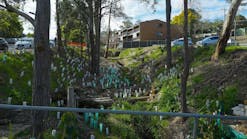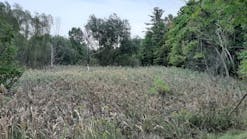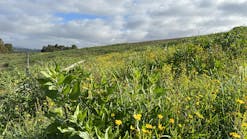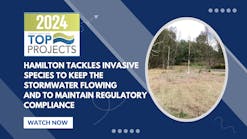Polymer Use and Testing for Erosion and Sediment Control on Construction Sites
In the Pacific Northwest, wet weather conditions often shorten the summer construction season and increase project duration. To comply with National Pollutant Discharge Elimination System (NPDES) permit requirements and prevent adverse environmental effects, construction during the wet season (October through April) requires effective site management to prevent sediments from entering surface waters. Erosion prevention best management practices (BMPs) are usually more effective and less expensive than BMPs that remove sediment from runoff after it has been mobilized.
Though generally useful for removing the coarser sediments, sediment control BMPs simply do not work well enough to reduce turbidity to meet the highly restrictive water-quality standards of Washington state. Suspended silt and clay-size particles cloud water clarity, resulting in turbidity that can be present for many hours or even days after coarser sediments have settled or otherwise been trapped.
With silts and clays present in most Pacific Northwest soils, any construction job – regardless of size – has the potential to create turbid runoff and, even with considerable BMPs, risks exceeding Washington’s strict turbidity standard. According to state regulations (WAC 173-201A), discharges must not raise turbidity by more than 5 nephelometric turbidity units (NTUs) or 10% above background in lakes and Class AA and Class A streams (the vast majority of the numerous water bodies in western Washington). Few other states have such a numerical standard for turbidity. Fines of up to $10,000 per day of noncompliance are possible (RCW 90.48). Several years ago, penalties for erosion control violations and damage to a nearby salmon stream amounted to $65,000 for a commercial development in the region (Bremerton Sun, 1996).
Even with properly implemented erosion prevention BMPs, construction sites can easily mobilize finer particles that can escape sedimentation facilities. Given that the sedimentation process is rarely optimal and highly limited in capturing the fine silts and clay-size particles (5-10 microns) responsible for turbidity, two needs are apparent: (1) the importance of erosion prevention and (2) improved sediment controls.
Typical silt fences are capable of trapping only sands and coarse silts, particles larger than about 125 microns (for example, in a silt fence with an apparent opening size of 100). Regional guidelines call for conventional sedimentation ponds to be designed to remove particles only as small as 20 microns (medium silts) (Washington Department of Ecology, 1992; King County, 1998). To provide even more treatment, some have overdesigned these ponds to remove even smaller particles down to 10 microns (fine silts), resulting in a threefold increase in net volume requirements. Doing so uses more project area and escalates project costs while providing marginal improvements in sediment trapping. Importantly, these larger ponds provide no safeguard against potential turbidity standard exceedances. Once suspended, fine silt and clay particles readily pass through conventional sedimentation facilities and contribute turbidity in runoff, illustrating a “technology gap” in the ability to effectively meet turbidity standards.
Chemical polymers promise a cost-effective, safe means of closing this gap by preventing soil erosion in the first place and by removing suspended sediments from construction-site runoff. Domestic water supplies and agriculture have used numerous polymers for water and soil treatment in the past few decades (Azzam, 1980; Roa, 1996). In Washington, several agencies and private industries have also investigated polymers as treatment BMPs on construction projects (Minton, 1999). Recent tests in the region have included treating soils directly with polyacrylamide (PAM) and treating runoff in batch systems using a conventional water treatment polymer. Other means of treating runoff with PAM using simple, passive, self-dosing systems hold promise and are currently being tested in the area.
These polymers have a high capacity to bind with soils and suspended particles. In a soil application, PAM aggregates soil particles, increasing pore space and infiltration capacity and resulting in reduced runoff. These larger particle aggregates are less susceptible to raindrop and scour erosion, thus reducing the potential to mobilize sediments. In water-treatment applications, polymers coagulate suspended particles, improving flocculation and increasing sedimentation rates.
Many types of water and soil treatment polymers exist, including PAM, polyamines, and aluminum-chloride polymers. PAMs are classified according to their molecular weight, and ionic charge or ionicity is categorized as anionic, cationic, or nonionic. PAMs are available in solid, granular, liquid, or emulsion forms. The literature indicates that anionic PAMs of higher molecular weight, such as Chemco 9107GD and 9836A, provide the best results and present little concern for toxicity (Sojka and Lentz, 1996). Effective doses of anionic PAM for water and soil treatment are generally an order of magnitude or more below toxic concentrations. The polyaluminum-chloridebased Cat-Floc 2953 presents certain yet tractable safety, handling, and pH control issues but has relatively low toxicity to aquatic life (Calgon Corporation, 1997). Other polymers may be suitable as coagulants for domestic water treatment, but their greater toxicity to aquatic organisms precludes their use in surface-water discharges (Betz Laboratories, 1995). The polymers discussed here conform to National Sanitation Foundation Standard 60 for use in drinking-water treatment.
The Washington State Department of Transportation (WSDOT) constructed an erosion control test facility along SR 8 in western Thurston County, WA, approximately 16 mi. due west of Olympia. Test objectives were to evaluate the optimum dosing method and PAM application rates for preventing erosion to exposed soils as evaluated through runoff turbidity data. The WSDOT SR 8 test site is located on the western flank of the Black Hills, a low mountain range due south of the Olympic Mountains and formed from Pleistocene-era basalt deposits. Test plots used onsite soils classified as Godfrey silt loam (hydrologic soil group C) consisting of 77% sand, 16% silt, and 7% clay (23% fines). Jar tests showed that these soils produce moderate turbidity (150-350 NTUs) under the low-intensity rainfall conditions typical in the area. The area’s rainfall is characterized by long-duration, low-intensity storms. Average annual rainfall at the WSDOT SR 8 test site ranges from 55 to 60 in. with 8-10 in. of snowfall. A full-time weather station at the site recorded hourly weather observations during the study period.
In the eight aboveground test plots, loose soil was contained in 4-ft.-long x 2-ft.-wide x 6-in.-deep wood-frame boxes. Runoff was diverted to sampling containers via a 45º V-notch weir and funnel. The boxes were placed on a 3.5:1 slope with a north-facing aspect. Holes drilled along the bottom of the downgrade end of each box allowed infiltrated water to escape, preventing waterlogging of the soil profile. The soil surfaces in each of the boxes were treated with different soil stabilizers, primarily different concentrations of PAM. Stormwater runoff from each box was then analyzed to measure the product’s ability to reduce erosion as indicated by turbidity in the runoff.
The PAM used in these tests was Chemco 9836A granular anionic polyacrylamide, which was chosen primarily because of its extensive use in agriculture and its excellent performance in verification tests conducted by the US Department of Agriculture/Agricultural Research Service in Kimberly, ID (Sojka and Lentz, 1996). Another product, Vanson Chitosan, an effective water treatment flocculant manufactured from crab shells and squid pens, was also applied, but only at a single concentration. Table 1 lists the soil treatments and application rates.
| Table: 1. Soil Treatments & Application Rates at WSDOT SR 8 Test Site | |||
| Test Box # | Treatment Type | Conc. (mg/l) | Equivalent Application Rate, kg/ha (lb./ac.) |
| 1 | Dry PAM | 0.84 grams | 11.2 (10.00) |
| 2 | Chitosan | 80 | 0.74 (0.66) |
| 3 | Wet PAM | 200 | 1.33 (1.19) |
| 4 | Wet PAM | 120 | 0.82 (0.72) |
| 5 | Wet PAM | 80 | 0.74 (0.66) |
| 6 | Wet PAM | 40 | 0.37 (0.33) |
| 7 | Wet PAM | 10 | 0.09 (0.08) |
| 8 | Control | none | none |
In the dry application, the PAM was mixed with approximately 3 oz. of sand to aid visual observation and applied using a saltshaker type of apparatus. In the wet applications, treatments were sprayed using a conventional hand-pumped spray applicator. A total treatment solution of 0.1 gal. was sufficient to wet the entire soil surface, resulting in an equivalent volumetric application of approximately 720 gal./ac. It is important to note that the soil surface was wetted, not saturated. The degree of saturation might be an important variable for applying PAM to exposed soil but was not evaluated in this round of tests.
The WSDOT NW region staff applied similar PAM (Chemco 9107GD) to soils on three highway construction sites in the Puget Sound region: SR 202 Ames Lake Road, SR 5 Stanwood Weigh Station, and SR 5 Ash Way Park and Ride. The objectives were twofold: to demonstrate the effectiveness of PAM in preventing erosion and to explore simple application methods. Potential PAM effectiveness, or “baseline,” was first tested simply by sprinkling water on PAM-dosed site soils in small boxes and then measuring turbidity in the runoff. Full-scale applications then used granular PAM that was first dissolved in water in 5-gal. buckets, then poured into a conventional water truck that was subsequently filled. PAM mixtures were then pumped through a hose and sprayed onto site soils.
Five soil treatments were tested in October 1998 through January 1999: untreated, hydromulch and seed only, PAM only, PAM plus hydromulch and seed, and PAM plus straw mulch. Test sites were 0.4, 11.8, and 13.5 ac. and had 6:1 to 3:1 cut and/or fill slopes of 100-400 ft. long on south and northwest aspects. Soils had 14-38% fines (silts and clays). Slopes were track walked, leaving cleat impressions parallel to contours prior to PAM application. Other conventional BMPs were used and in such a manner that they would not influence the areas tested. PAM was applied at a concentration of 120 mg/l at the rate of 1 lb./ac., which volumetrically is 1,000 gal./ac.
Runoff samples from test areas were collected passively in simple plastic containers or plastic-lined trenches placed parallel to grade at the toe of slopes. Five to 10 storms were sampled in the October 1998 through January 1999 period. Turbidity was measured with a Hach turbidimeter.
A large construction project began the first chases of the five-plus-year construction of a new third runway at Seattle-Tacoma International Airport (Sea-Tac). In 1998, approximately 1 million yd.3 of fill material was imported to build the beginnings of the embankment for the new runway. Hauling began in late May 1998 and continued vigorously until complete on December 18, 1998. The approximate dimensions of the completed embankment earthwork were 75 ft. high x 1,200 ft. long x 500 ft. Fill material consisted of sand and gravel typical of the glacial material underlying the Puget Sound region, with maximum fine material (silts and clays) content of less than 5%. Finished sideslopes were 2:1, typically with 40-60 ft. of length between the two intermediate drainage benches designed to intercept and direct slope runoff to drainage facilities.
A wide array of conventional structural erosion and sediment control BMPs and project phasing considerations were used to minimize the potential for erosion of the imported fill material. To minimize exposed fill material, sideslopes were tracked and then hydroseeded with Soilguard bonded fiber matrix periodically as work progressed. More than half of the total slope length was complete with vigorous grass growth by late September 1998. Because of schedule constraints and production rates, applying cover material (straw or other mulch) to the top of the fill was impractical. Active work areas were sloped to drain runoff away from slopes and into interceptor ditches via pipe slope drains. A wheel-wash sump on the haul road exit prevented trucks from exporting material off-site.
Rock and geotextile-lined interceptor ditches along the project perimeter collected all runoff and drained it to an overdesigned sedimentation pond. This 1.8-ac.-ft. pond had a length-to-width ratio of 20:1 at overflow and was oversized considerably by two design factors intended to improve sedimentation performance and provide enough detention to minimize the possibility of bypasses. First, the design storm was increased from the 10-year to the 25-year, 24-hour event, then the target particle size was reduced from 20µm to 10µm. These two factors increased total volume and area by a factor of three beyond what would result with the local guidelines (Washington Department of Ecology, 1992; King County, 1994). This pond also served as the holding and presettling basin for the polymer treatment system immediately downstream.
Polymer Batch Treatment System
The polymer treatment system was approved in July 1998 as an experimental BMP by the local regulatory agency (Washington Department of Ecology) and was similar to others used in the area described by Minton (1999). The system was located to serve current and future phases of runway embankment construction. Turbid sediment-pond effluent was dosed with Cat-Floc 2953, a polyaluminum-based conventional water treatment polymer. Water was treated at a concentration of 100 mg/l as it was pumped by a 700-gpm pump through 4-in. PVC piping. When necessary, pH was adjusted with sodium bicarbonate during treatment. Treated water was settled in one of three 20-mil plastic-lined treatment cells of 85,000-90,000 gal. excavated on-site. When turbidity dropped to suitable levels, treated batches were pumped out of the cell for discharge to the local storm-drain outfall to nearby Miller Creek.
Accumulated sediments were periodically pumped out by conventional vactor truck and disposed of off-site. Ten percent of the treated batches were tested for potential toxicity using onsite daphnids (water fleas) and fish bioassays prior to discharge. One or two personnel staffed the plant during each batch treatment operation corresponding to a particular storm discharge. Turbidity, pH, and conductivity were measured in grab samples taken before, during, and after each batch was treated and released. Background turbidity in the receiving stream was also measured in grab samples taken upstream of the discharge outfall. Turbidity was measured with a Hach turbidimeter. These grab samples are assumed to represent the nominal conditions for each batch.
All three project tests were conducted during the local wet season, October 1998 through April 1999. During this period, weather in the Pacific Northwest was dominated by the more frequent rainfall caused by the La Niña weather pattern. Sea-Tac Airport received a total of 39.9 in. in this period, which was 12 in. more than usual and just about equal to the average annual rainfall. In November 1998, rainfall at Sea-Tac Airport exceeded the 30-plus-year historical records by about 0.9 in., setting a new record at 11.6 in.
At the Thurston County test facility, different soil applications of PAM were evaluated over six extended rainstorms in October and November 1998 and February 1999. After a single application, the full treatment range was tested during three storms in October and November 1998. Subsequent testing during three storms in February 1999 used the apparent optimal dosage of 80 mg/l applied once to new soils. Total rainfall in each storm varied from 0.28 in. over six days to 7.01 in. over three days. The turbidity data for runoff from each storm revealed a distinctive U-shaped dose/response curve, indicating an optimal dosage of 80 mg/l. Figure 1 shows results from the November 4-6 storm of 0.74 in., which were typical of all data.
Figure 1 clearly shows that there is an optimum dosing range for applying PAM on soils. For this particular soil/slope combination, the most effective PAM dosage was in the 40- to 80-mg/l range, corresponding to 5-10 oz./ac. Higher dosage rates did not necessarily result in less turbidity. In fact, for wet application, the 10-mg/l treatment was more effective than the 200-mg/l treatment for all the storms monitored. The dry application also was quite effective, although it required at least 10 times more PAM per unit area for the same level of effectiveness.
Table 2 shows the mean turbidity reduction for each treatment during the test period. Chitosan was ineffective for the application tested and actually resulted in increased turbidity.
| Table 2. Mean Turbidity Reduction From PAM-Treated Soils | |||
| Box# | Treatment | # of Events | Turbidity Reduction |
| 1 | 11 kg/ha dry PAM | 3 | 55% |
| 2 | 80 mg/l Chitosan | 3 | -111% |
| 3 | 200 mg/l wet PAM | 3 | 22% |
| 4 | 120 mg/l wet PAM | 3 | 43% |
| 5 | 80 mg/l wet PAM | 6 | 82% |
| 6 | 40 mg/l wet PAM | 3 | 72% |
| 7 | 10 mg/l wet PAM | 3 | 53% |
Runoff from PAM-treated soils had higher pH than controls, increasing pH by a few tenths at higher PAM concentrations. The dry PAM application (greatest mass load) showed the most pH variation versus the control; however, rainfall pH may be a factor.
Bioassays using daphnids were conducted in February 1999 on test-plot runoff from three storms using an 80-mg/l wet-applied PAM solution. Acute tests showed zero mortality for the runoff from PAM-treated soils, the untreated soil runoff, and the control. Chronic (reproduction) bioassays showed similar results for PAM-treated and untreated tests, which were significantly different than the control. Thus, the chronic results indicated effects associated with the untreated runoff; therefore chronic effects attributable to PAM are not indicated.
Results from the SR 5 Weigh Station test site, the largest of the three sites, are considered the most representative of an active construction site. Sample collection techniques were different on the smaller SR 202 site, where the primary focus was on developing application techniques. Activity on the SR 5 Ash Way Park and Ride test site yielded unrepresentative results, which are not included.
Simulated runoff from soils of both sites showed a 90% “baseline” turbidity reduction for PAM test treatments in the controlled “box test.” On the actual construction sites, runoff from PAM treatments alone showed 88-90% reductions compared to bare soil. PAM also improved hydromulch and seed performance. (See Table 3.) Turbidity in runoff from the control typically ranged from 70 to 15 NTUs. Total rainfall ranged from 0.01 to 1.4 in. during the five to 10 events sampled. At the SR 5 Weigh Station site, the sampling apparatus was improved after the first three storms, so data from only seven events are included in Table 3.
| Table 3. WSDOT Construction-Site PAM Tests | |||
| Site | Treatment | # of Storms | Turbidity Reduction |
| SR 202 | PAM only | 5 | 88-90% |
| SR 202 | PAM + hydromulch | 5 | 94-99% |
| SR 202 | Hydromulch only | 5 | 22-95% |
| SR 5 Weigh Station | PAM + straw | 7 | 57-82% |
Despite the many conventional erosion and sediment control BMPs implemented on the runway embankment project, the sediment-pond effluent was considerably turbid. During early wet season construction in November and December 1998, sediment-pond turbidity ranged from 71 to more than 1,000 NTUs. Beginning in mid-January 1999, a few weeks after fill operations were completed, turbidity dropped to lower ranges exponentially (R2 = 0.5). Turbidity continued to drop despite the continued frequent, above average rainfall in February and early March 1999. This trend appears in Figure 2, where the decreasing turbidity illustrates the combined effects of ceasing disturbance (fill import) and the increasing stability afforded by the erosion prevention BMPs. Note that in early December, several of the highest turbidity readings were measured during a period of lower rainfall. According to onsite observations, several high readings were suspected to be the result of resuspension of sediments previously trapped in ditches or behind check dams. A total of 11 of these 14 maximum values measured exceeded 1,000 NTUs, the upper limit of the turbidimeter instrument when used without sample dilution.
Runoff from each storm event was treated, for a total of 232 batches in the five-month period. Only one bypass occurred for a limited period during a late November 1998 storm that exceeded the sediment pondsize design event.Table 4 summarizes the 225 batches analyzed in this article (seven batches lacked complete data). Overall, the treatment system considerably reduced turbidity over a wide range of influent turbidity and total treatment contact periods. Reductions are computed as the difference between the turbidity in grab samples of treatment system influent (turbid water pumped from the sediment pond) and the treated water after settling. Additional reductions in turbidity occurred after settling and before final release to the receiving stream (some batches were held overnight).
| Table 4. Data Summary for 225 Treated Batches | ||||||
| Volume, m3 |
pH | Inlet Turbidity, NTUs |
Outlet Turbidity, NTUs |
Turbidity, Reduction |
Contact Time, min.** |
|
| Max. | 350 | 7.6 | 1,000* | 46 | 99.97% | 780 |
| Median | 285 | 7.0 | 226 | 7 | 97.6% | 140 |
| Min. | 133 | 5.9 | 13 | 0.1 | 46% | 35 |
| * A total of 11 of the 14 maximum values measured exceeded 1,000 NTUs, the upper limit of the instrument when used without sample dilution. For these “high censored” data, the value of 1,000 NTUs was used for computing reduction, therefore reductions could be greater. | ||||||
| ** A total of 39 batches held overnight before discharge is not included in these calculations. | ||||||
Figures 3 and 4 show that a large portion (greater than 92%, more than 200) of the batches treated resulted in turbidity reductions of better than 90%, even with as little as two hours of total contact time. More than 84% of the treated discharges were below background turbidity in the creek. None of the treated discharges exceeded the turbidity standard applicable to Miller Creek at the time of release. For November 1998, the wettest period, Figure 5 shows these results, which were typical of other periods.
The batch treatment system resulted in large turbidity reductions over a wide range of influent turbidity values. Figure 3 shows that above 70 NTUs, reduction was consistently above 80%. Below 60 NTUs, however, there was more variation in reduction, ranging from 46% to more than 90%. Some have suggested that polymers can be less effective at lower influent concentrations, which seems to be apparent in the data here, yet absolute turbidity reductions still fulfilled the treatment objective of no exceedances of the receiving-water standard.
Without treatment, discharges from the sediment pond would have been problematic in meeting the receiving-water turbidity standard; just one batch would have met guidelines. Upstream turbidity in Miller Creek measured prior to discharge of each treated batch was generally less than 40 NTUs. Therefore, the standards were these instream background measurements plus 5 NTUs. Given this small increase allowable, 15 batches would have been less than 50 NTUs above standards, and a total of 41 batches less than 100 NTUs above standards. Thus, if numerical standards were less restrictive, allowing short-term exceedances, say, by up to 50-100 NTUs, then treatment would have been unnecessary for 7-18% of the 225 batches, respectively. It would be interesting to compare these differences in turbidity strictly on a visual basis similar to the state of Georgia’s new standard (University of Georgia, 1998).
Startup costs for the batch treatment system amounted to $90,000, yet costs for some of the initial piping might have been unwarranted. Monthly expenses averaged $18,000 for operations and maintenance and $13,000 for materials and equipment. Total project costs for this first phase totaled about $245,000, less than 1% of total construction costs.
Much of the startup costs will be amortized over future phases of the embankment construction. Labor costs were higher than what would be anticipated for future work as a result of training needs in this first phase of the project. Of course, overall operating costs were driven higher by the record rainfall and extremely wet weather. Thus, given project experience and typical rainfall, start-up and operating costs would be much less in future work. Nonetheless, operating these sophisticated onsite systems represents a “cost of compliance” given current options.
Studies undertaken in the Puget Sound region of Washington during the very wet La Niña weather of 1998 and 1999 demonstrated that polymers can be effective erosion prevention and sediment control BMPs for construction sites. Single wet applications of PAM to soils reduced runoff turbidity considerably up to six weeks or more. And given similar application methods (truck-sprayed), PAM can be applied for a fraction of the material cost of conventional “cover” materials, such as hydromulch. Wet PAM applications of less than 1 oz./ac. in a 10-mg/l solution reduced turbidity considerably. Optimal wet PAM application doses were 40-80 mg/l. Dry application of granular PAM can be effective also but requires more than 10 times the material, by weight, to yield the same effectiveness as wet-applied PAM. Thus, PAM application rates, methods, and concentrations should be adjusted to maintain optimal effectiveness, which may vary with each site. Because of ease in application, PAM is well suited as a short-term erosion prevention BMP, especially for areas with limited access or steep slopes that hinder personnel from applying other cover materials. PAM can be used to augment other cover practice BMPs, though it can be effective applied alone.
Conventional sediment ponds, even when oversized, do little to reduce turbidity. Because of this practical limitation and a highly restrictive turbidity standard in Washington, construction managers should place high priority on erosion prevention practices. To meet standards in western Washington, treatment of turbid construction-site runoff using Cat-Floc 2953 is one option that is highly effective given adequate funding and system operation but can result in a considerable “cost of compliance.” The intensive infrastructure requirements for such a treatment system, however, might not be suitable for all construction projects. Passive PAM dosing concepts should be further tested.





